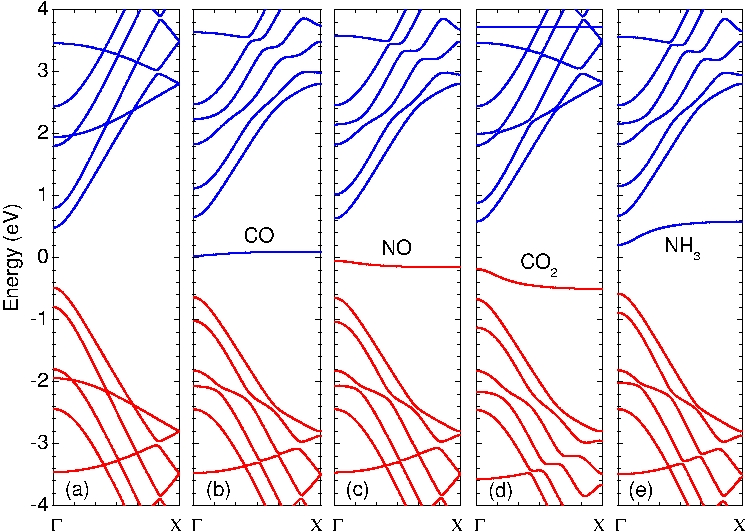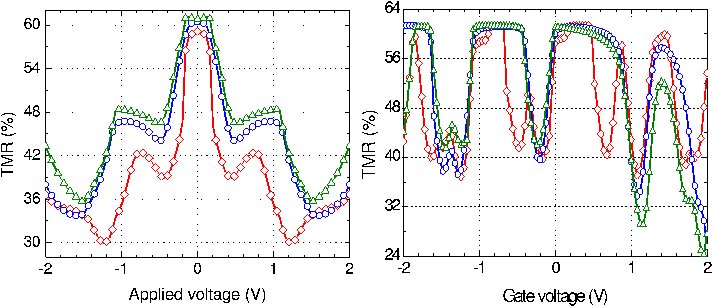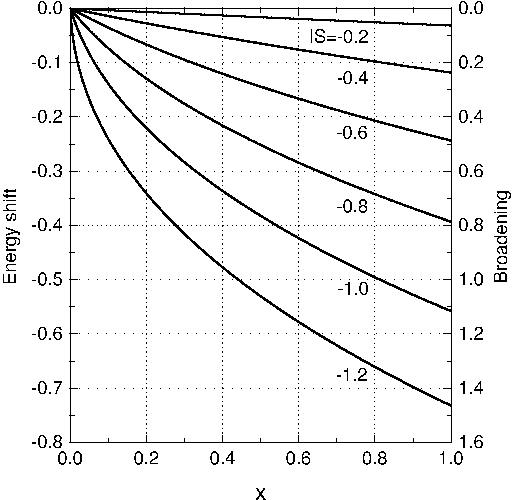In this research, using the parameters obtained from DFT results, we have modeled the adsorption of gas molecules CO, NO, CO2, and NH3 on the 10-AGNR. Under the assumption that the variation in bond lengths between carbon atoms is only localized on the edges of ribbon, and including this effect in our calculations, we studied the influence of finite concentrations of the adsorbates on the average LDOS. In addition, we assumed that only one molecule can occupy the ribbon sites and there is no interaction among the adsorbed molecules. The results show that, although all types of gas molecules can influence the electronic properties of the system, the average LDOS varies from one type to other. In the cases of CO and NO molecules adsorption, the impurity states are very localized at the center of original band gap. Therefore, adsorption of these gas molecules on 10-AGNR cannot notably affect the charge transport through such systems. In the cases of CO2 and NH3 adsorption, however, the system exhibits p-type and n-type semiconducting behavior, respectively. Despite the simplicity of the model, reasonable agreement with DFT results is demonstrated. The results can be useful in designing future gas sensors and p-type or n-type semiconductors.

Using the nonequilibrium Green’s function (NEGF) method and the Landauer–Büttiker theory, we have investigated the possibility of making a C60-based magnetic tunnel junction. We have shown that coupling between the single C60 molecule and magnetic electrodes in FM/C60 /FM structure produces large magnetoresistance effects (greater than 60%) that can be modulated by using the molecule orientation, bias, and gate voltages to control the spin-polarized transport. The result of this project, advances the fundamental understanding of spin-dependent transport in molecular junctions and suggests that C60 molecule is an interesting candidate for application in the magnetic memory cells and spintronic devices. In this study, the effects of inelastic scattering and the magnetic anisotropy of the FM electrodes due to the reduced dimensionality and the geometry of the system have been ignored. These factors can affect the spin-dependent transport, and hence, another improved approach is needed for more accurate results.

We have studied the effects of magnetic and nonmagnetic impurities on the electronic states of semiconductor quantum wires. Using the coherent potential approximation (CPA) for random distribution of impurity atoms, we investigated the influence of impurity concentration and the strength of exchange interaction on the LDOS. In nonmagnetic semiconductor quantum wires, the acceptor (donor) impurities only shift the bands towards lower (higher) energies, and the van Hove singularities in the LDOS depend on the value of impurity concentration. For diluted magnetic semiconductor (DMS) quantum wires, the magnetic impurities broaden the bands and reduce continuously the peaks sharpness, even in the case of weak exchange coupling. The results presented here predict that the DMS quantum wires can be used in laser operation and the physics of spintronic nanodevices.

We have presented a new formalism to study the temperature dependence of surface magnetization in the local moment systems. Based on the single-site CPA for the s–f model and the mean-field theory for the layerdependent magnetization we have investigated how the surface influences the spin-dependent electronic states. The effect of the semi-infinity of the crystal was taken into account by a localized perturbation method. Assuming a s.c. band structure for the s electrons we obtained the numerical results for the LDOS and the electron–spin polarization for various temperatures and in two different behaviors at the surface; ordinary and surface transitions. These transitions depend on the values of the exchange coupling constants between atoms on the surface and between atoms in the layers n = 1 and n = 2. The results showed that in the surface transition case, in which the coupling constants are higher than the corresponding in the bulk, the surface Curie temperature Tc(s) lies well above the bulk Curie temperature. Therefore, at temperaturs between Tc(b) and Tc(s), the electron–spin polarization on the surface has a finite value, while the bulk spin polarization is zero. The existence of the surface magnetization and hence, the spin-polarized surface states above the bulk Curie temperature can be useful for development of new electron-polarized devices.